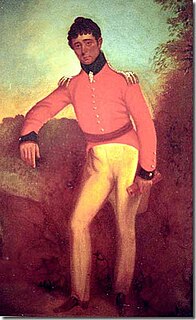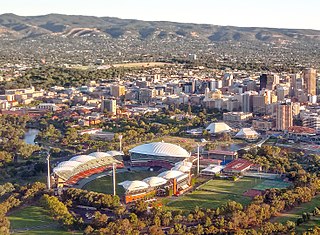Gawler is the oldest country town on the Australian mainland in the state of South Australia, and is named after the second Governor of the colony of South Australia, George Gawler. It is about 40–44 km (25–27 mi) north of the centre of the state capital, Adelaide, and is close to the major wine producing district of the Barossa Valley. Topographically, Gawler lies at the confluence of two tributaries of the Gawler River, the North and South Para rivers, where they emerge from a range of low hills.

This article details the History of Adelaide from the first human activity in the region to the 20th century. Adelaide is a planned city founded in 1836 and the capital of South Australia.
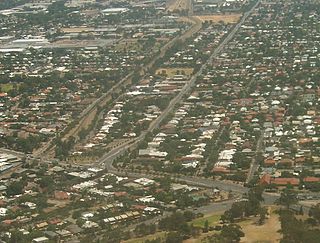
Prospect is the seat of the City of Prospect and an inner northern suburb of greater Adelaide. It is located 5 km (3.1 mi) north of Adelaide's centre.

Government House, located in Adelaide on the corner of North Terrace and King William Road, is the official residence of the Governor of South Australia.

Light Square also known as Wauwi is one of five squares in the City of Adelaide. Located in the centre of the north-western quarter of the Adelaide city centre, the Square is named after the city's planner, Colonel William Light.
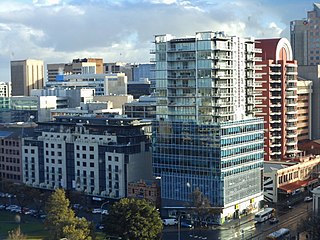
Hindmarsh Square is a public square in Adelaide, South Australia. It is located in the centre of the north-eastern quarter of the city, and surrounds the intersection of Grenfell and Pulteney Streets, near the eastern end of the Rundle Mall. Pirie Street forms the southern boundary of the square. It was named by the Street Naming Committee after John Hindmarsh, the first Governor of South Australia.

Gouger Street is a main street in the centre of Adelaide, South Australia. It was named after Robert Gouger, first Colonial Secretary of South Australia. Gouger Street is known for its high-end international restaurants and cafes. Cuisines found along Gouger Street include Italian, French, Argentinian, Malaysian, Vietnamese, Chinese and Thai. Many of the restaurants on Gouger Street have won awards; some of the better known ones are Star of Siam, La Porchetta (Italian) and Chi on Gouger.

Ovingham is an inner northern suburb of Adelaide, South Australia. It is located in the cities of Charles Sturt and Prospect.

Pulteney Street is a main road which runs north-south through the middle of the eastern half of the Adelaide city centre, in Adelaide, South Australia. It runs north-south from North Terrace, through Hindmarsh and Hurtle Squares, to South Terrace, where it becomes Unley Road, and subsequently,, becomes Belair Road.

Morphett Street is a main street in the west of the city centre of Adelaide, South Australia. It runs from south to north between South and North Terraces, and passes around and through two of the five squares in the Adelaide city centre: Light Square and Whitmore Square. At Hindley Street it transforms into the start of the bridge which crosses North Terrace, the railway yards and the River Torrens.

Frome Road is a connecting road in the South Australian capital city of Adelaide. It starts from North Terrace in the Adelaide city centre, running in a northerly direction past the University of South Australia, the old Royal Adelaide Hospital, the Institute of Medical and Veterinary Science and the University of Adelaide, and then through the Adelaide Parklands to the Adelaide Zoo where it turns northeasterly, crosses the River Torrens via Albert Bridge, and continues through the parklands to the intersection with Melbourne Street and Brougham Place in North Adelaide. Adelaide's newest school has just opened here and it's called Adelaide Botanic high school. It is one of the three roads connecting the city centre to North Adelaide, the others being King William Road and Montefiore Road.

Grenfell Street is a major street in the north-east quarter of the centre of the city of Adelaide, South Australia. The street runs west-east from King William Street to East Terrace. On the other side of King William Street, it continues as Currie Street. Its intersection with Pulteney Street is encircled by Hindmarsh Square.

East Terrace marks the eastern edge of the city centre of Adelaide, the capital city of South Australia. It is one of the main north-south thoroughfares through the east side of the city. Although the terrace essentially runs north-south between North Terrace and South Terrace, unlike Adelaide's other three terraces, its path is far from a straight line; travelling the entire length of East Terrace requires turning at right angles at most intersections. After crossing South Terrace, the street continues through the parklands as Beaumont Road, but unlike other roads through the parklands it is not a thoroughfare; there is a break in the middle of it.
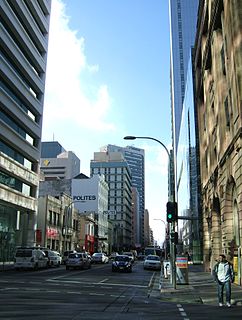
Waymouth Street is an east-west street running between West Terrace and King William Street in the centre of Adelaide, the capital city of South Australia. The street is named after Henry Waymouth, a founding director of the South Australian Company. Until 1863 it was almost invariably spelled "Weymouth"; the eponymous director was then given either spelling interchangeably.





